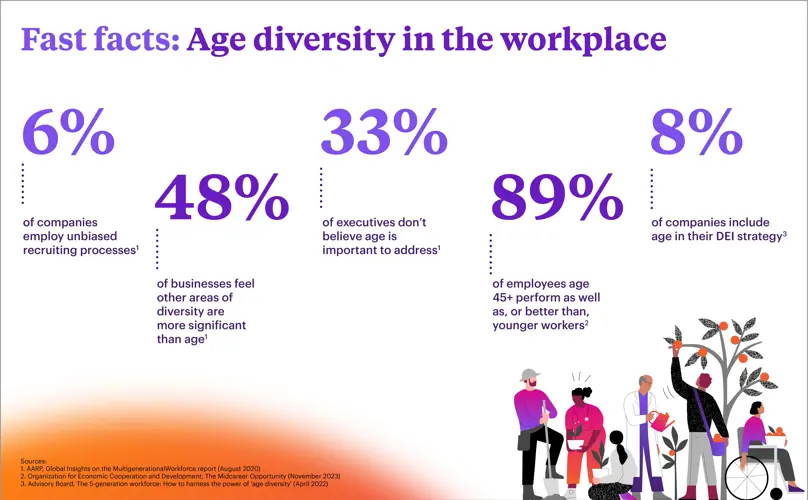For the first time, there are five generations in the workforce: Gen Z, millennials, Gen X, baby boomers, and Silents. All have varying backgrounds and levels of skill and experience, together trying to overcome challenges and achieve business goals. But as harmful age biases flourish, collaboration can be a complex endeavor, especially when awareness is lacking.
The benefits of age diversity
A perspective shift is needed in the world of work. There’s much more to be done on the road to global acceptance – and it starts with understanding the importance of celebrating and supporting employees of all ages.
Here are four major ways having a multigenerational workforce can impact your organization, along with five steps for increasing it:
1. Productivity
An age-diverse workforce fosters a broader range of skills, viewpoints, and knowledge, fueling creativity. Each employee contributes their own set of talents and efforts to the team. And with such varied experience, the complementary support between workers leads to better collaboration and greater overall productivity. Multigenerational teams have even been shown to increase individual performance, for both young and older generations.
Industry stat: Age diversity – especially the presence of younger generations in medical centers – has a significant and positive impact on organizational performance and patient satisfaction.
2. Increased revenue
The best match for an age-diverse market is an age-diverse workforce. A variety of backgrounds bring unique approaches to problem-solving. And happy customers bring in stronger revenue. Increasingly more business leaders are seeing the value in multi-age teams, as companies with above-average age diversity report 19% greater revenue and 9% higher profit margins than companies with below-average age diversity.
Industry stat: Age-diverse workforces in advanced manufacturing have a positive effect on the bottom line, as well as employee engagement and productivity.
3. Innovation
Experience across generations provides a kaleidoscope of perspectives. Looking through these distinct lenses opens the door for inventive and original solutions that are more difficult – or impossible – to come by with homogenous teams. Each generation has something to contribute: fresh ideas and agility to technological skill. Mixed experiences and the expertise of older employees have been proven to spark notable innovation.
Industry stat: More than 60% of advanced manufacturing companies use multigenerational teams to improve productivity and enhance innovation.
4. Employee retention
Studies show that age diversity improves employee turnover rates. A multigenerational workforce leads to increased moments of learning and mentorship, providing employees with better growth and development. As individual and team success swells so does morale and engagement – both strong predictors of talent retention.
Industry stat: A diverse healthcare workforce creates a sense of belonging for employees through making them feel valued and supported, leading to improved retention rates and higher job satisfaction.
How to increase age diversity in the workplace
1. Educate employees on age biases
Awareness is the first step to fostering an age-inclusive culture – particularly when it comes to intergenerational differences. Educate leaders and team members on the importance of age diversity and how to spot and prevent age biases. Adopt and enforce age discrimination policies as part of your inclusion initiative. And assess workplace protocols to ensure they resonate with all age groups.
Industry stat: Only 6% of life sciences employees feel their leaders are equipped to lead a multigenerational workforce.
2. Embrace anonymized hiring practices
A culture and brand that supports a multigenerational team is crucial for attracting and retaining talent of all ages. Anonymized hiring practices – eliminating graduation dates and years of work experience – and using age-neutral language in job postings, along with other inclusive talent acquisition strategies, will unlock widespread talent potential. By eliminating any latent biases, the focus remains on skills and other culture adds.
3. Make employee development a priority
Career paths are more fluid. Providing robust training for employees of all ages encourages continuous improvement while working to combat age biases – especially as older workers change careers or reenter the workplace. Reskilling and upskilling programs help future-proof your employees and business, in a world where more than half of all workers – no matter their age – will need to learn new skills.
4. Establish a mentorship program
Younger generations want experienced mentors to help acclimate them to their field and to instill valuable knowledge. With reverse mentoring, early-career employees can share skills and perspectives with older generations. These cross-generational training opportunities help give employees a sense of purpose while allowing workers of all ages to flourish. Thoughtfully matching mentors and mentees, providing best practices, and setting up a structured progress plan are just a few of the ways to set up an effective mentorship program.
5. Offer flexible benefits & working options
With the rise of remote and hybrid work, employees of all ages now have more varying preferences for the way – and where – they do their jobs. Some may prefer the digital nomad lifestyle, while others wish to work unconventional hours. Providing options suited to employees’ working styles and inclusive benefits that align with different life stages – from financial counseling to elder care – will ensure your team feels supported, translating to greater productivity and retention.
Key takeaway
Creating a multigenerational environment and promoting age-inclusive practices will go far in encouraging a more supportive – and successful – world of work. The generational divide doesn’t have to be divisive. All employees, regardless of generation, ultimately desire the same things: meaning, purpose and growth. With awareness and care, you can ensure everyone reaches their goals.
About the expert

Senior Vice President – Responsible Business & Impact, Cielo
LinkedIn connect






